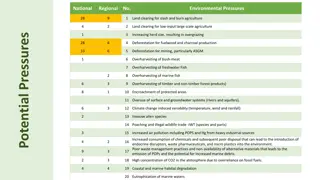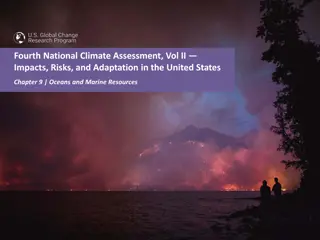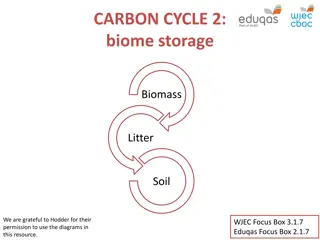Understanding Biomes: Climate, Ecosystems, and Threats
Biomes are large regions with distinct climates, plant, and animal communities, each consisting of multiple ecosystems. The main factors shaping biomes are temperature and precipitation, influencing the types of organisms that can thrive in each region. Tropical rain forests, for example, are critical habitats with exceptional biodiversity but face severe threats like deforestation and habitat destruction.
Download Presentation

Please find below an Image/Link to download the presentation.
The content on the website is provided AS IS for your information and personal use only. It may not be sold, licensed, or shared on other websites without obtaining consent from the author. Download presentation by click this link. If you encounter any issues during the download, it is possible that the publisher has removed the file from their server.
E N D
Presentation Transcript
What is a Biome? Biomes are large regions characterized by a specific type of climate and certain types of plant and animal communities. Each biome is made up of many individual ecosystems.
Biomes and Climate Climate is the average weather conditions in an area over a long period of time. Climate is the main factor is determining which plants can grow in a certain area, which in turn defines the biome. Temperature and precipitation are the two most important factors that determine a region s climate.
Temperature and Precipitation Most organisms are adapted to live within a particular range of temperatures and will not survive at temperatures too far above or below their range. Precipitation also limits the organisms that can be found in a biome because all organisms need water, and the bigger the animal, the more water it needs.
Tropical Rain Forests Tropical rain forests are forests or jungles near the equator. They are characterized by large amounts of rain and little variation in temperature and contain the greatest known diversity of organisms on Earth. They help regulate world climate an play vital roles in the nitrogen, oxygen, and carbon cycles. They are humid, warm, and get strong sunlight which allows them to maintain a fairly constant temperature that is ideal for a wide variety of plants and animals.
Threats to Rain Forests Every minute of every day, 100 acres of tropical rainforest are cleared for logging operations, agriculture, and oil exploration. Exotic-pet trading robs the rain forests of rare and valuable plant and animal species only found there. Habitat destruction occurs when land inhabited by an organism is destroyed or altered. If the habitat that an organism depends on is destroyed, the organism is at risk of disappearing.
Threats to Rain Forests An estimated 50 million native peoples live in tropical rain forests and are also threatened by habitat destruction. Because they obtain nearly everything they need form the forest, the loss of their habitat could force them to leave their homes and move into cities. This drastic change of lifestyle may then cause the native peoples too lose their culture and traditions.
Temperate Forests Temperate rain forests are forests communities that are characterized by cool, humid weather and abundant rainfall, where tree branches are draped with mosses, tree trunks are covered with lichens, and the forest floor is covered with ferns. They occur in North America, Australia, and New Zealand, and are dominated by evergreen trees such as the Douglas fir and Sitka spruce.
Temperate Deciduous Forests Temperate deciduous forests are forests characterized by trees that shed their leaves in the fall, and located between 30 and 50 north latitude. The range of temperatures can be extreme, with summer temperatures soaring to 35 C and winter temperatures often falling below freezing. They receive 75 to 125 cm of precipitation annually which helps to decompose dead organic matter contributing to the rich soils of the forest.
Taiga The taiga is the region of evergreen, coniferous forest below the arctic and subarctic tundra regions. The taiga has long winters and little vegetation. The growing season can be as short as 50 days with most plant growth occurring during the summer months because of nearly constant daylight and larger amounts of precipitation.
Savannas Savannas are plains full of grasses and scattered trees and shrubs that are found in tropical and subtropical habitats. Found mainly in regions with a dry climate, such as East Africa and western India. Although savannas receive little precipitation throughout the year, they do have a wet season and a dry season. Many animals are only active during the wet season. Grass fires help to restore nutrients to the soil during the dry season.
Temperate Grasslands Temperate grasslands are communities (or biomes) that are dominated by grasses, have few trees, and are characterized by hot summers and cold winters, with rainfall that is intermediate between that of a forest and a desert. Temperate grasslands have the most fertile soil of any biome. Few natural temperate grasslands remain because many have been replaced by grazing areas and farms growing crops such as corn, soybeans, and wheat.
Temperate Grasslands Temperate grasslands are located on the interiors of continents where too little rain falls for trees to grow and include the prairies of North America. Mountains often play a crucial role in maintaining grasslands as rain clouds from the west are blocked. However, rainfall does increase as you move eastward, allowing taller grasses to grow. Heavy precipitation is rare in the grasslands, allowing the hot temperatures in the summer to make the grasslands susceptible to fires.
Chaparral Chaparral is a type of temperate woodland biome with vegetation that includes broad leafed evergreen shrubs and is located in areas with hot, dry summers and mild, wet winters. Chaparrals are located in the middle latitudes, about 30 north and south of the equator. Chaparrals are located primarily in coastal areas that have Mediterranean climates.
Deserts Deserts are regions that have little or no vegetation, long periods without rain, and extreme temperatures. Although there are hot and cold deserts, one characteristic they both share is the fact that they are the driest places on Earth. Deserts are often located near large mountain ranges because mountains can block the passage of moisture-filled clouds, limiting precipitation.
Tundra The tundra is a treeless plain that is located in the Arctic or Antarctic and that is characterized by very low winter temperatures, short, cool summers, and vegetation that consists of grasses, lichens, and perennial herbs. Summers are short in the tundra, so only the top few centimeters of soil thaw. Permafrost is the permanently frozen layer of soil or subsoil and can be found in the tundra regions.























